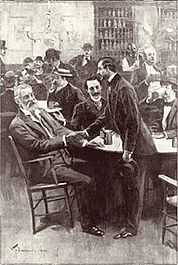Pfaff's beer cellar
Coordinates: 40°43′36″N 73°59′45″W / 40.72675°N 73.99580°W

Pfaff's was a drinking establishment in Manhattan, New York City, known for its literary and artistic clientele.
Description
Opened in 1855 by Charles Ignatious Pfaff, the original Pfaff’s was modeled after the German Rathskellers that were popular in Europe at the time. Charles Pfaff's beer cellar was located on Broadway near Bleecker Street (before 1862, Pfaff's address was given as 647 Broadway; after 1865, its location was advertised as 653 Broadway) in Greenwich Village, New York City. To enter the beer cellar—which was actually a vaulted ceiling bar and restaurant—its patrons had to go down a set of stairs.
From the mid-1850s to the late 1860s, Pfaff’s was the center of New York’s revolutionary culture. As writer Allan Gurganus has said, "Pfaff’s was the Andy Warhol factory, the Studio 54, the Algonquin Round Table all rolled into one."[1]
Habitués included journalist and social critics Henry Clapp, Jr., Walt Whitman, Ada Clare, poet and actress Adah Isaacs Menken, playwright John Brougham, and artist Elihu Vedder. Whitman called Charlie Pfaff "a generous German restaurateur, silent, stout, jolly," as well as "the best selector of champagne in America."[2] Whitman also wrote an unfinished poem about Pfaff’s called "The Two Vaults," which included the lines:
...The vault at Pfaffs where the drinkers and laughers meet to eat and drink and carouse
While on the walk immediately overhead pass the myriad feet of Broadway...
Clapp, considered by many the "King of Bohemia", founded The Saturday Press as New York's answer to the Atlantic Monthly. Started as a literary magazine, The Saturday Press eventually became a countercultural zine "with a mix of poetry, stories, radical politics, and an enthusiastic spirit of personal freedom and sexual openness. Before it folded in 1868, it published numerous poems by Whitman and a short story by Mark Twain. The Saturday Press championed Leaves of Grass, a move that many view as a significant factor in the success of the 1860 edition."[3]
In 1870, Charles Pfaff moved his business up to midtown. Whitman wrote about Pfaff’s in Specimen Days after a visit to the restaurateur's newer location many years later:
An hour’s fresh stimulation, coming down ten miles of Manhattan Island by railroad and 8 o’clock stage. Then an excellent breakfast at Pfaff’s restaurant, 24th Street. Our host himself, an old friend of mine, quickly appear’d on the scene to welcome me and bring up the news, and, first opening a big fat bottle of the best wine in the cellar, talk about ante-bellum times, '59 and '60, and the jovial suppers at his Broadway place, near Bleecker Street.Ah, the friends and names and frequenters, those times, that place. Most are dead - Ada Clare, Wilkins, Daisy Sheppard, O’Brien, Henry Clapp, Stanley, Mullin, Wood, Brougham, Arnold - all gone.
And there Pfaff and I, sitting opposite each other at the little table, gave a remembrance to them in a style they would have themselves fully confirm’d, namely, big, brimming, fill’d-up champagne-glasses, drain’d in abstracted silence, very leisurely, to the last drop.[4]
Current status
The original location at 653 Broadway eventually became an envelope factory. In 1975, it became a disco called Infinity, which was destroyed by fire in 1979. Today, the location is home to a few shops.
In the spring of 2011, the Vault at Pfaff’s was re-established at 643 Broadway. Like in the original, today's patrons descend a set of stairs into a refurbished cellar.[5]
The subterranean lounge serves wine, cocktails (classic and "themed"), and food from a small but upscale menu, which is now printed on newspaper and resembles The Saturday Press format made famous by Henry Clapp, Jr. The oak bar, a prominent feature of the space, is over 150 years old. During restoration of the space, a 19th-century fieldstone wall was discovered and now accents the back room. The furniture design in the Vault is inspired by a saloon car design from the mid-19th century period. Katherine Blackburne, a New York City based artist, collaborated with designer Mark Zeff to paint panels on the back of the sofas to echo saloon car murals popular at that time. References to notable authors, artists, politicians and stars are evident throughout the space. As recounted in Whitman's unfinished poem about Pfaff’s, there are also two vaults in today's space.
References
- ↑ http://therumpus.net/2010/07/walt-whitman%E2%80%99s-watering-hole-pfaff%E2%80%99s-cellar-nyc/
- ↑ http://www.poetrybay.com/winter2004/whitman.html
- ↑ http://therumpus.net/2010/07/walt-whitman%E2%80%99s-watering-hole-pfaff%E2%80%99s-cellar-nyc/
- ↑ http://www.poetrybay.com/winter2004/whitman.html
- ↑ "The Vault at Pfaff’s: a Historically Significant Date Spot in Noho". UrbanDaddy. April 20, 2011. Retrieved July 21, 2012.
Further reading
- Mark A. Lause (2009). The Antebellum Crisis & America's First Bohemians. Kent State University Press. ISBN 978-1-60635-033-1.
- Hart, James D. (1995). The Oxford Companion to American Literature (WITH REVISIONS AND ADDITIONS BY PHILLIP W. LEININGER) (6th ed.). Oxford University Press, USA. ISBN 978-0-19-506548-0.
- Edward Whitley, Rob Weidman, and others. "The Vault at Pfaff's – An Archive of Art and Literature by New York City's Nineteenth-Century Bohemians". Lehigh University Digital Library. Retrieved April 30, 2010.
- "Whitman's New York". PBS. Retrieved April 30, 2010.